Hatysa, Iota Orionis (ι Ori), is the primary component in a multiple star system located approximately 1,340 light-years away in the constellation Orion. Composed of several hot, luminous, blue components, the Iota Orionis star system is part of the open cluster NGC 1980. It forms Orion’s Sword with 42 Orionis, Theta Orionis, and the Orion Nebula (M42).
Star system
Iota Orionis is a multiple star system composed of three visible components: the triple star Iota Orionis A, the blue giant Iota Orionis B, and the A-type star Iota Orionis C. The system has an apparent magnitude of 2.77.
Iota Orionis A consists of three hot, blue, evolved stars. The primary component, formally known as Hatysa (Iota Orionis Aa1), is a luminous blue supergiant star of the spectral type O9 III. Hatysa forms a massive double-lined spectroscopic binary system with a blue giant or subgiant star (Iota Orionis Aa2) of the spectral type B0.8 III/IV. The two components have an orbital period of 29.1338 days and a semi-major axis of 132 solar radii.
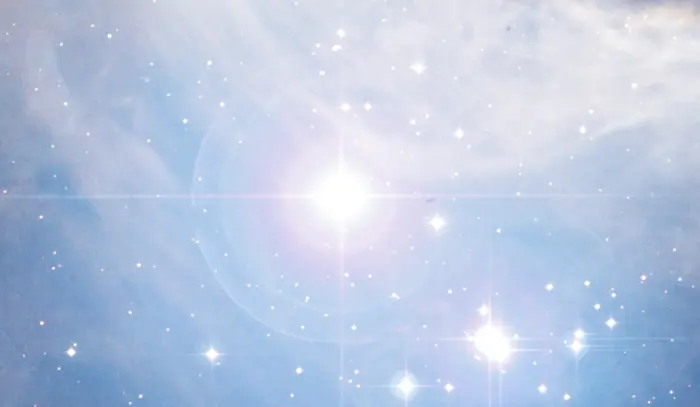
Hatysa (Iota Orionis), cropped image, credit: ESO/Digitized Sky Survey 2 (CC BY 4.0)
Hatysa is the more massive of the two stars. The supernova candidate has a mass 23.1 times that of the Sun and a radius of 8.3 solar radii. With a surface temperature of 32,500 K, it is 68,000 times more luminous than the Sun. The star has a projected rotational velocity of 122 km/s. It is believed to be 4 – 5.5 million years old.
Iota Orionis Aa2 is also a supernova candidate. It has a mass of 13.1 solar masses and a radius 5.4 times that of the Sun. With an effective temperature of 27,000 K, it shines with 8,630 solar luminosities. The star has an estimated age of 9.4 million years. It is about 2 magnitudes fainter than Hatysa. The two components have the combined spectral type of O9 III.
The binary system is a strong X-ray source due to the interaction of the components’ stellar winds. The components appear to have different ages, which is unusual for a binary pair. It indicates that the system may have been created through a capture during an encounter between two separate binary stars.
Iota Orionis Ab, the third component, is separated by 155 milliarcseconds from the main pair. The star is believed to be a B2 giant, but its properties are uncertain.
Iota Orionis B appears at a separation of 11.3 arcseconds from Iota Orionis A, corresponding to a physical distance of about 5,000 astronomical units.
The component B has the spectrum of a hot blue giant star of the spectral type B8 III. However, it is believed to still be a young stellar object. It is a helium-weak chemically peculiar star with 5.12 times the Sun’s mass and an effective temperature of 18,000 K. It has an estimated age of around 3 million years.
Iota Orionis B is classified as an Orion variable and has the variable star designation V2451 Orionis. Orion variables are very young stars that exhibit irregular and eruptive changes in luminosity. They are usually found near diffuse nebulae. These stars are believed to become non-variable when they reach the zero-age main sequence.
Iota Orionis C is a star of the spectral type A0, cooler and less massive than its blue neighbours.
NGC 1980: The Lost Jewel of Orion
Iota Orionis is the brightest member of the open cluster NGC 1980. Nicknamed the Lost Jewel of Orion, the cluster occupies an area of 14 by 14 arcminutes of the apparent sky and has an apparent magnitude of 2.5. It lies 1,793 light-years (550 parsecs) away and is associated with an emission nebula.
NGC 1980 appears at the southern tip of the Orion Nebula (M42). It contains 18 other stars brighter than 14th magnitude. Members include HR 1886 and HR 1887, which shine at fifth magnitude. Most other brighter stars in the cluster are 9th magnitude.
NGC 1980 was discovered by the German-born British astronomer William Herschel on January 31, 1786. The cluster has an estimated age of 4.7 million years. It is also catalogued as Collinder 72.
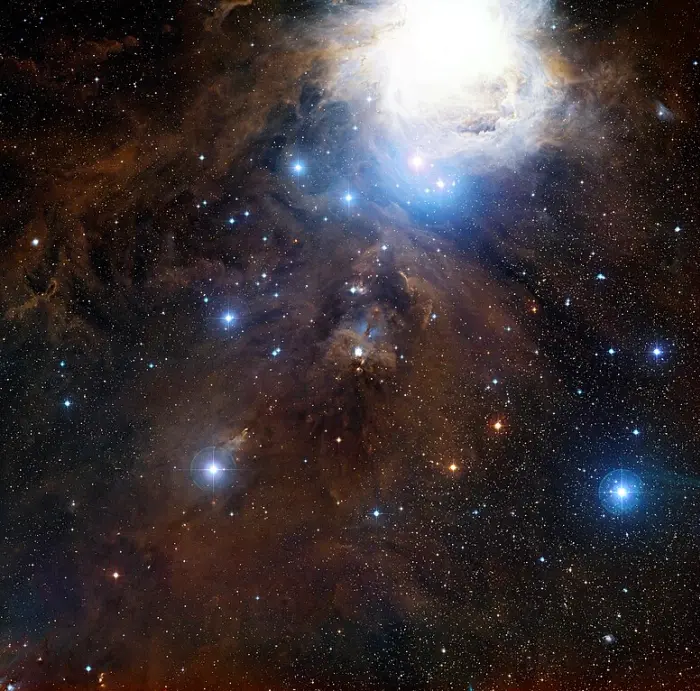
This wide-field view shows a region of sky in the famous constellation of Orion (The Hunter), as seen in visible light. The large, bright feature at the top of the image is the well-known Orion Nebula (Messier 42). This view was created from images forming part of the Digitized Sky Survey 2. Image: ESO/Digitized Sky Survey 2 (CC BY 4.0)
Facts
With an apparent magnitude of 2.77, Hatysa is the eighth brightest star in the constellation Orion, after Rigel, Betelgeuse, Bellatrix, Alnilam, Alnitak, Saiph, and Mintaka.
The seven brighter Orion stars form the familiar hourglass figure of the celestial Hunter. Betelgeuse and Bellatrix mark the Hunter’s shoulders, Rigel and Saiph the legs, and Alnitak, Alnilam and Mintaka form the Belt of Orion. The fainter Meissa marks Orion’s Head and the group of stars that share the Bayer designation Pi Orionis form Orion’s Shield.
Hatysa is the brightest point of light in Orion’s Sword, a conspicuous asterism that appears just below Orion’s Belt. The Sword asterism is also formed by the multiple star system 42 Orionis in the Running Man Nebula and Theta1 Orionis (the Trapezium Cluster) and Theta2 Orionis at the core of the Orion Nebula (M42). The Iota Orionis system is the southernmost point of light in the Sword.
The stars of Orion’s Sword are members of the Orion OB1c subgroup of the Orion OB1 association. They are 3-6 million years old.
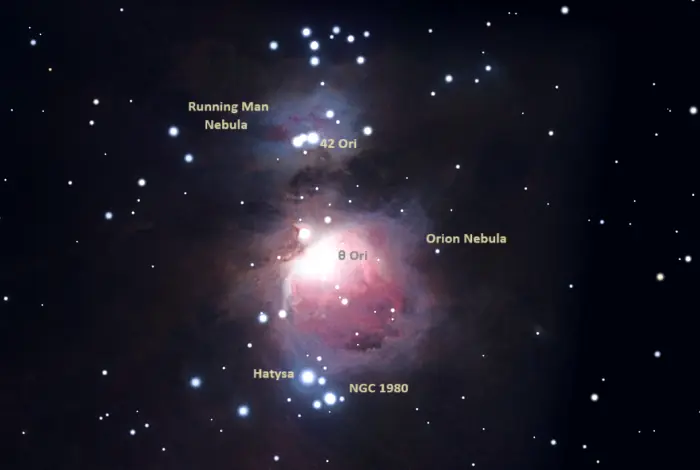
Orion’s Sword, image: Stellarium
The hot blue O-type star AE Aurigae may have once been a member of the Iota Orionis system. The runaway star is believed to have been expelled from its star system during a collision of two massive binary stars about 2-3 million years ago. Mu Columbae and 53 Arietis may have been ejected at the same time. The common point of origin of these three stars intersects with Hatysa.
AE Aurigae lies 1,320 light years away in the constellation Auriga. It is the central star of the Flaming Star Nebula, an emission and reflection nebula 5 light-years across. Like Iota Orionis B, AE Aurigae is an Orion variable. Its brightness varies from magnitude 5.78 to 6.08.
In Chinese astronomy, Iota Orionis was part of the Punishment asterism, also formed by 42 Orionis and Theta2 Orionis in Orion’s Sword. The asterism was part of the larger Three Stars mansion, which represented the body of the White Tiger.
Name
The name Hatysa (pronunciation: /hɑːˈtiːsə/) comes from Czech astronomer Antonín Bečvář’s Atlas Coeli (1951). Its origin is unknown.
The name was approved by the International Astronomical Union’s (IAU) Working Group on Star Names (WGSN) on September 5, 2017. It formally applies only to the primary component in the star system, Iota Orionis Aa.
Iota Orionis was traditionally known as Nair al Saif, “the Bright One of the Sword.” The name comes from the Arabic phrase nayyir as-sayf.
Location
Hatysa is very easy to find because it appears within the bright, recognizable constellation figure of Orion. It is part of Orion’s Sword and lies just below the Orion Nebula. It forms a triangle with the supergiants Rigel and Saiph.
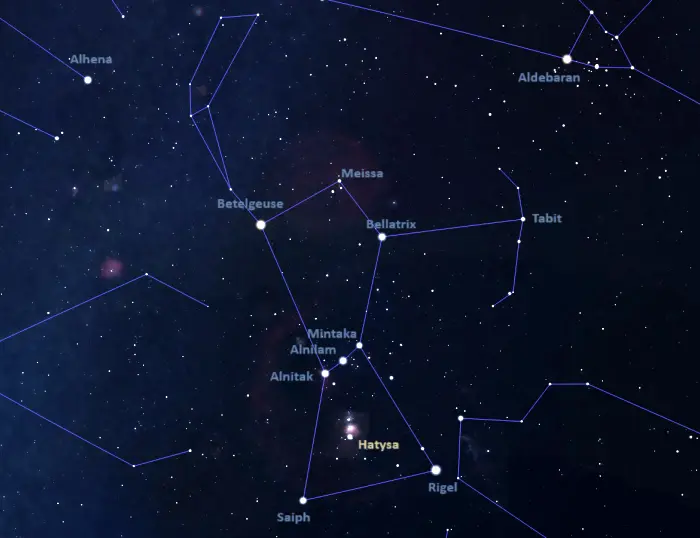
The location of Hatysa (Iota Orionis), image: Stellarium
Constellation
Hatysa lies in the equatorial constellation of Orion. Representing the Greek mythical hunter, Orion is one of the oldest constellations in the sky. It was one of the 48 Greek constellations catalogued by the Greco-Roman astronomer Claudius Ptolemy in his Almagest in the 2nd century CE.
Orion stretches across 594 square degrees of the sky on the celestial equator and is the 26th largest of the 88 constellations.
The constellation is known for its many massive stars and bright deep sky objects. It hosts Rigel and Betelgeuse, the seventh and 10th brightest stars in the sky. Like most bright stars in Orion, the two supergiants will end their lives as supernovae.
The blue supergiants Alnitak and Alnilam and the bright giant Mintaka form Orion’s Belt, one of the most familiar asterisms in the night sky. The celestial Hunter’s head is marked by Meissa, another exceptionally massive star, and his legs by the blue supergiants Rigel and Saiph. Bellatrix is the only one of the constellation’s brightest stars that may not go out as a supernova when it comes to the end of its life cycle. The other stars that form the hourglass figure of the Hunter are all supernova candidates.
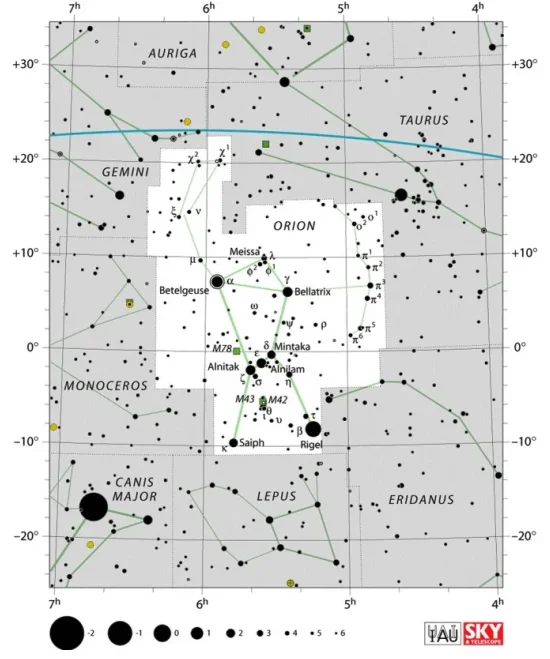
Orion constellation map by IAU and Sky&Telescope magazine
Other than the Orion Nebula (Messier 42), bright deep sky objects in Orion include De Mairan’s Nebula (Messier 43), the reflection nebulae Messier 78 and NGC 1999 (the Cosmic Keyhole), the dark Horsehead Nebula (Barnard 33), and the emission nebulae NGC 2174 (the Monkey Head Nebula), NGC 2024 (the Flame Nebula), Sharpless 264 (the Lambda Orionis Ring), and Barnard’s Loop.
The best time of the year to observe the stars and deep sky objects in Orion is during the month of January, when the constellation appears high above the horizon in the early evening. The entire constellation is visible from locations between the latitudes 85° N and 75° S.
The 10 brightest stars in Orion are Rigel (Beta Ori, mag. 0.05 – 0.18), Betelgeuse (Alpha Ori, mag. 0.0 – 1.3), Bellatrix (Gamma Ori, mag. 1.59 to 1.64), Alnilam (Epsilon Ori, mag. 1.64 – 1.74), Alnitak A (Zeta Ori A, mag. 2.00), Saiph (Kappa Ori, mag. 2.09), Mintaka AB (Delta Ori AB, mag. 2.23), Hatysa (Iota Ori, mag. 2.77), Tabit (Pi3 Ori, mag. 3.16), and Eta Orionis (mag. 3.31 – 3.6).
Hatysa – Iota Orionis
| Spectral class | O9 III + B0.8 III/IV + B2:IV + B8 III + A0 |
| Apparent magnitude | 2.77 |
| Distance | 1,340 light-years (412 parsecs) |
| Constellation | Orion |
| Right ascension | 05h 35m 25.98191s |
| Declination | –05° 54′ 35.6435″ |
| Names and designations | Hatysa, Iota Orionis, ι Ori, Na’ir al Saif, ADS 4193, CCDM J05355-0555, IDS 05305-0559, WDS J05354-0555 |
Iota Orionis A
| Spectral class | O9 III + B0.8 III/IV + B2:IV |
| U-B colour index | -1.08 |
| B-V colour index | -0.24 |
| Parallax | 1.40 ± 0.22 mas |
| Radial velocity | 27.60 ± 0.3 km/s |
| Proper motion | RA: +1.42 ± 0.21 mas/yr |
| Dec.: -0.46 ± 0.13 mas/yr | |
| Right ascension | 05h 35m 25.9819073s |
| Declination | –05° 54′ 35.643537″ |
| Names and designations | Iota Orionis A, ι Ori A, 44 Orionis, HD 37043, HR 1899, HIP 26241, SAO 132323, FK5 209, BD−06°1241, GC 6937, GCRV 3425, PLX 1279.00, PPM 188225, HGAM 444, JP11 5722, JP11 5724, JP11 5723, 2E 1377, 2E 0532.9-0556, 1ES 0532-05.9, N30 1201, MCW 341, Parenago 2037, EUVE J0535-05.9, GSC 04778-01401, TD1 4942, TIC 427395774, 1RXS J053526.3-055436, UBV 5526, UBV M 51705, UBV M 51706, ALS 14790, IRAS 05330-0556, 2MASS J05352597-0554357, WEB 5136, WH 301, NGC 1976 721, TYC 4778-1401-1, ADS 4193 A, CCDM J05355-0555A, IDS 05305-0559 A, WDS J05354-0555A, WDS J05354-0555Aa,Ab |
Iota Orionis Aa1
| Spectral class | O9 III |
| Mass | 23.1 M☉ |
| Luminosity | 68,000 L☉ |
| Radius | 8.3 R☉ |
| Temperature | 32,500 K |
| Metallicity | +0.10 dex |
| Age | 4 – 5.5 million years |
| Rotational velocity | 122 km/s |
| Surface gravity | 3.73 cgs |
Iota Orionis Aa2
| Spectral class | B0.8 III/IV |
| Mass | 13.1 M☉ |
| Luminosity | 8,630 L☉ |
| Radius | 5.4 R☉ |
| Temperature | 27,000 K |
| Age | 9.4 ± 1.5 million years |
| Surface gravity | 3.78 cgs |
Iota Orionis B
| Spectral class | B8 III |
| Variable type | Orion variable |
| Parallax | 2.787 ± 0.0476 mas |
| Radial velocity | 16 km/s |
| Proper motion | RA: 1.129 ± 0.050 mas/yr |
| Dec.: 1.622 ± 0.039 mas/yr | |
| Mass | 5.12 M☉ |
| Temperature | 18,000 K |
| Age | ~3 million years |
| Surface gravity | 4.0 cgs |
| Right ascension | 05h 35m 26.4561867264s |
| Declination | -05° 54′ 44.447086188” |
| Names and designations | Iota Orionis B, ι Ori B, V2451 Orionis, V2451 Ori, HD 37043B, BD-06 1241B, GCRV 3426, 2MASS J05352645-0554445, HGAM 445, ALS 19593, CSV 100603, Parenago 2051, NSV 2334, ISOY J053526.45-055444.4, PMSC 05305-0559B, ROT 3549, TIC 427395778, WEB 5140, TYC 4778-1402-1, Gaia DR2 3017190477921606400, Gaia DR3 3017190477921606400, ADS 4193 B, CCDM J05355-0555B, IDS 05305-0559 B, WDS J05354-0555B |
Iota Orionis C
| Spectral class | A0 |
| Parallax | 2.6058 ± 0.0242 mas |
| Proper motion | RA: 1.420 ± 0.024 mas/yr |
| Dec.: 0.690 ± 0.019 mas/yr | |
| Right ascension | 05h 35m 29.2026811464s |
| Declination | -05° 54′ 47.240222040” |
| Names and designations | Iota Orionis C, ι Ori C, Brun 731, Brun 749, ISOY J053529.20-055447.2, 2MASS J05352920-0554471, Parenago 2080, TIC 427395781, Gaia DR2 3017190477921396096, Gaia DR3 3017190477921396096, ADS 4193 C, CCDM J05355-0555C, IDS 05305-0559 B, WDS J05354-0555C |